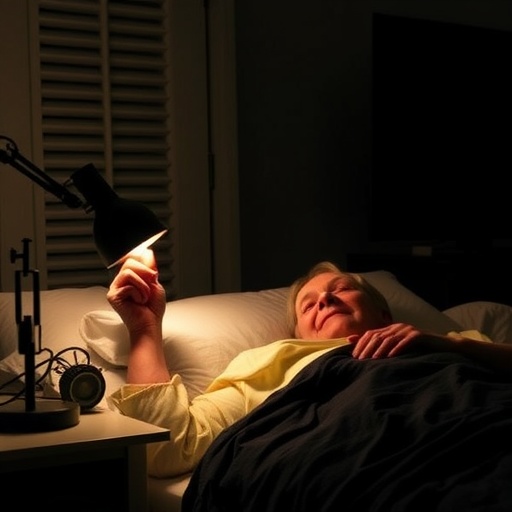
Impact of Nighttime Light and Noise on Sleep Quality Among Older Adults: A New Study Unveils Critical Insights
A recent study sheds light on the significant relationship between exposure to light and noise at night and the quality of sleep among community-dwelling older adults. Conducted by a team of researchers led by Dr. Shuying Dai, the cross-sectional study delves into how the environment during nighttime impacts an essential aspect of health—sleep. This research aims to address a growing concern among the geriatric population regarding the factors affecting their overall well-being.
Sleep, a fundamental human necessity, is intricately linked to the quality of life and health, particularly in older adults. With age, sleep patterns often become disrupted, leading to a myriad of health issues ranging from cognitive decline to increased risk of chronic diseases. The study emphasizes that environmental factors, such as artificial lighting and ambient noise, may exacerbate these sleep disturbances. Understanding these environmental impacts is vital as it can pave the way for practical interventions that foster better health outcomes in aging populations.
In contemporary society, nighttime has become an extension of daytime due to the omnipresence of artificial light. Street lamps, electronic devices, and indoor lighting create an illuminated landscape that many older adults are not immune to. This constant exposure to light at night can interfere with the body’s natural circadian rhythm, which regulates the sleep-wake cycle. The study highlights the physiological repercussions of this disruption, including an increase in cortisol levels and a decrease in melatonin production, both of which are critical for maintaining healthy sleep patterns.
Moreover, the research points out that not only light but also noise pollution plays a detrimental role in the sleep quality of older adults. Sounds from traffic, neighbors, or other urban activities can lead to fragmented sleep, resulting in increased wakefulness during the night. The more these individuals are exposed to such disturbances, the more likely they are to experience insomnia and other sleep-related disorders. This forms a complex interaction between light and noise, creating an environment that is far from conducive to restorative sleep.
From a methodological perspective, the study involved a comprehensive analysis of sleep quality using both objective and subjective measures. Participants were assessed through standardized questionnaires to evaluate their sleep habits, while additional tools measured their exposure levels to light and noise in their living environments. By employing both qualitative and quantitative techniques, the researchers ensured that their findings were grounded in robust data, thus enhancing the reliability of the study.
The study’s findings reveal a concerning trend: a significant portion of older adults report poor sleep quality correlated directly with increased exposure to nighttime light and noise. This relationship underscores the importance of awareness among caregivers and healthcare providers about environmental factors that may influence sleep in older adults. It urges them to consider these elements when making recommendations for improving sleep hygiene in this demographic.
In the context of public health, the implications of this study are profound. As the population ages, there is an urgent need to recognize and address the growing prevalence of sleep disturbances among older adults. By raising awareness of the potential dangers associated with nighttime light and noise exposure, the study advocates for societal changes that could promote healthier sleeping environments. Simple interventions, such as reducing light pollution in residential areas and minimizing noise during nighttime hours, could lead to substantial improvements in sleep quality.
Furthermore, the study proposes that urban planning and community design must incorporate considerations for the elderly. Creating quieter, darker environments could drastically enhance the quality of life for aging individuals. Such initiatives not only improve sleep but may also have a ripple effect on overall health outcomes, reducing the burden on healthcare systems that face the challenges associated with poor sleep among older adults.
Significantly, this research contributes to the growing body of literature on sleep health, illustrating the multifaceted nature of sleep disturbances in older adults. It highlights that addressing sleep quality is not solely a matter of clinical intervention but also a public health challenge that requires a multidisciplinary approach. By unearthing the connections between environmental factors, sleep, and health, the study lays the groundwork for future research aimed at pinpointing specific interventions that could mitigate these effects.
Additionally, the study’s findings prompt a call to action for further investigation into the individual differences among older adults concerning sensitivity to light and noise. Some individuals may be inherently more susceptible to these disturbances, suggesting that personalized approaches based on individual needs and preferences may yield better results in improving sleep quality.
As the research community continues to explore the intricacies of sleep in older adults, the importance of developing targeted strategies to mitigate the effects of light and noise remains paramount. It promotes the concept that the journey to better sleep is not just a personal endeavor but a collective responsibility that engages the wider community. By crafting more conducive living environments, we can cultivate a society where older adults thrive, not just survive, embracing their golden years with the restful sleep they deserve.
In conclusion, Dr. Dai and her colleagues have opened doors to a vital discussion surrounding sleep quality among older adults. Their meticulous study highlights the detrimental effects of nighttime light and noise, affirming the need for preventive measures that enhance sleep hygiene. As communities navigate the challenges of an aging population, integrating these findings into public health strategies becomes imperative.
Subject of Research: The relationship between nighttime light and noise exposure and sleep quality in community-dwelling older adults.
Article Title: Exposure to light and noise at night, and sleep quality in community-dwelling older adults: a cross-sectional study.
Article References:
Dai, S., Wang, W., Yang, K. et al. Exposure to light and noise at night, and sleep quality in community-dwelling older adults: a cross-sectional study. Eur Geriatr Med (2025). https://doi.org/10.1007/s41999-025-01254-4
Image Credits: AI Generated
DOI: 10.1007/s41999-025-01254-4
Keywords: Sleep quality, older adults, nighttime light, noise pollution, circadian rhythm, public health.
Tags: aging population health concernsartificial lighting impact on healthchronic diseases and older adultscognitive decline and sleep issuescommunity-dwelling seniors sleep studyenvironmental factors affecting sleepgeriatric sleep disturbancesnighttime light exposure effectsnoise pollution and sleep qualitypractical interventions for sleep improvementquality of life in older adultssleep patterns in aging populations





